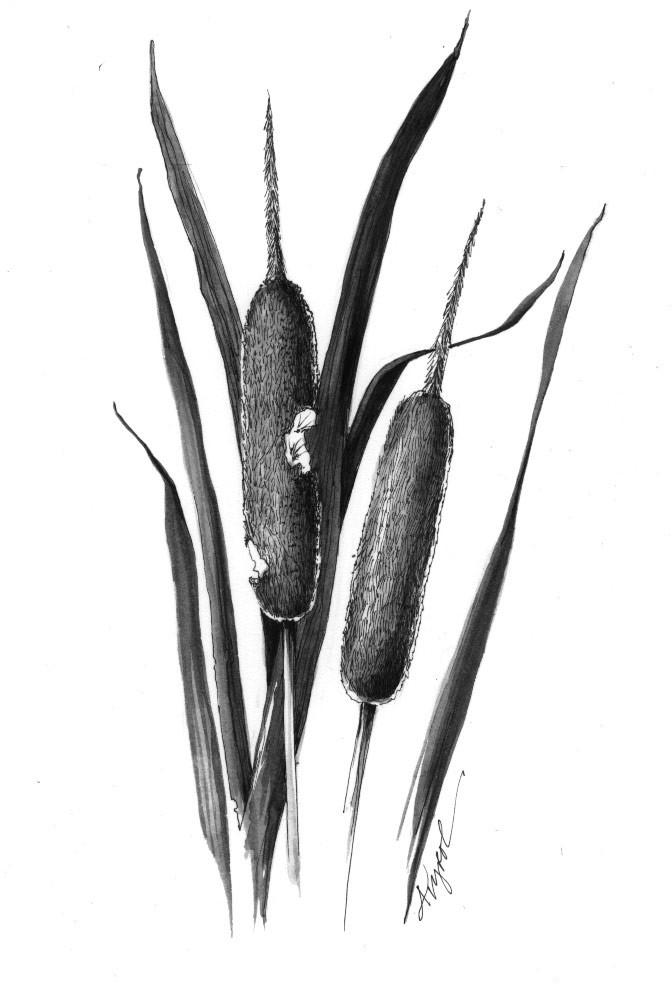With their feet firmly planted in the soil below the water and their heads high in the air above, cattails are a vital feature of ponds, bogs, and freshwater marshes. In early April, the tender green shoots of newly emerging cattails inspire various animal species to seek them out. The white inner centers of the young stems, which can be eaten raw or cooked, are considered a delicacy by both human foragers and aquatic mammals such as muskrats. For muskrats, cattails have the added advantage of supplying the tough leaves used for building their lodges. And for red-winged blackbirds—among the earliest migrants returning to our region—stands of cattails provide the perfect nesting place.
So familiar that we may hardly notice them, cattails are actually one of nature’s most extraordinary plants. While the common, or broad-leaved, cattail (Typha latifolia), which is native to North America, is probably seen most often in northern New England, the narrow-leaved cattail (Typha angustifolia), an exotic of European origin, is also found here. Frequently, the two varieties grow near each other in the same body of water.
Considered a perennial herb, cattails are related to the blue flag iris, and, like that plant, they grow from rhizomes. Similar to a bulb, a rhizome is a horizontal underground stem that generates both shoots and roots. Once established, a cattail rhizome continues to grow underwater, producing new shoots. These rhizomes spread so effectively that just a few individual plants can easily create an acre of cattails. Containing thickened areas where starch is stored, the rhizomes are a staple of the muskrat diet, and their appetite for this nutritious food helps keep cattail populations under control.
Geese like to eat cattail rhizomes too—a good thing, since cattails are unusually well equipped for reproductive success and can quickly establish a monotypic stand that reduces habitat value. Besides reproducing vegetatively, through rhizomes, cattails also reproduce sexually, through seeds. The flower head at the top of the stem is divided into two easily distinguishable parts. The pistillate (female, seed-bearing) section is the unique brown cylinder, a compact mass of tightly compressed, minute flowers containing 100,000 to 250,000 seeds. Above it rises the narrow, yellow spire of the staminate (male, pollen-producing) flowers. Blooming in late May or early June, cattails release their seeds when the flower spikes mature and burst in late summer. Each seed is carried inside a tiny fruit covered with bristly hairs that help in wind dispersal. When the fruit lands on water, the covering splits open and the seed sinks to the bottom. Under ideal conditions—plenty of light, warm temperatures, and low oxygen concentrations—the seed begins to germinate immediately, and the seedling will then spread by rhizomes. If the temperatures are too cold, the seeds can overwinter and germinate the following year.
At first glance, the common cattail and the narrow-leaved cattail look quite similar. Both are hardy plants that can grow as high as 9 feet, though the common cattail is the true opportunist, happy to grow in shallow water and less organically rich soil. Seen together in the same pond or marsh, the two are fairly easy to distinguish. Besides its notably slender leaves, the narrow-leaved variety will prefer deeper water, while the common variety tends to stick closer to the edges. When in doubt, check the flower spike. On the common cattail, the pistillate and staminate sections of the flower grow together with no break, while on the narrow-leaved cattail, the two parts are separated by a gap of 1 to 4 inches.
By mid April, cattail stands are truly busy places—and not just because of the foraging opportunities. This is the time when muskrats are born, either in bank burrows or lodges. Often described as “small beavers,” muskrats give birth to litters of between five and eight. The beaver comparison is apt, as muskrats also have a thick layer of waterproof underhair, partially webbed hind feet, and the ability to stay underwater for as long as 17 minutes. Unlike the beaver, the muskrat—which is truly the largest member of the North American mouse family—has a long, narrow, naked tail. Though muskrats do not build dams, they have such an appetite for aquatic plants that they clear areas of open water in marshy areas, which then attract migrating waterfowl and other birds.
Higher up in the cattails, red-winged blackbirds will begin building their deep, narrow nests of reeds and grasses, attaching them to the stems, and laying their eggs in late April. The three to four eggs will hatch after about 12 days. By the time the cattails are blooming in early summer, young muskrats will be swimming and diving in search of a meal, while young red-winged blackbirds will be swaying on the stems above, calling out their distinctive check-tee-err.


